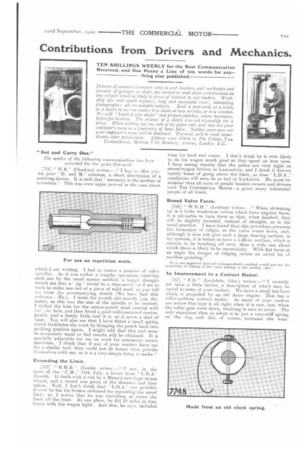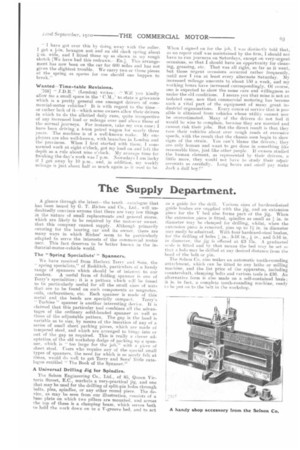Contributions from Drivers and Mechanics.
Page 21

Page 23

If you've noticed an error in this article please click here to report it so we can fix it.
TEN SHILLINGS WEEKLY for the Best Communication Received, and One Penny a Line of ten words for any
thing else published.
Drivers of commercial-motor vehic'es and tractors, and mechanics and foremen of garages ur shops, are invited to send short contributions on any subject winch is likely to Prove of interest to our readers. Workshop tips and smart repairs ; long and successful runs ; interesting photographs : mill are suitable subjects. Send a post-card, or a letter, or a sketch to us---no ;natter how short, or how written, or lmw worded. We will " knock it into shape" and prepare sketches, where necessary, before puWication, The absence of a sketch dies not disqualify for a prize. When writing use one side of the paper only and amen 'ion your employer's immune no a guarant:e of bona fides. Neither your own nor your employer's name will be disclosed. Payment will be made immediately after publicatiem. Address your letters to The Editor, THE COMMERCIAL MOTOR, 7-15, Rosebery Avenue, London, E.C.
"Dot and Carry One."
The sender of the following communication has &ea awarded the 10s. prize this week.
[764] " H.B." (Cheshire) writes :—" I beg to offer you, for your D. and M.' columns, a short description of a centring device. It is said that ` necessity is the mother of invention.' fhis was once again proved in the ease about
which I am writing. I had to centre a number of valve spindles. As it was rather a lengthy operation, centring each one by the usual square method, a happy thought struck me that a ' jig ' would be a time-saver, so I set to work to make one out of a piece of mild steel, as you will Ncc from the accompanying sketch [We have had this redrawn.—ED.]. I made the mouth end exactly ;-in. diameter, as this was the size of the spindle to be centred. I drilled the hole for the centre-punch dead central with the c-iii. hole, and then fitted a good well-tempered centrepunch, and a handy little tool it is, as it saves a deal of time. You will also see that I have fitted a small spring which facilitates the work by bringing the punch back into striking position again. I might add that this tool must be accurately made or bad results will be obtained. It is specially adaptable for use on work for automatic turret machines. I think that if any of your readers have use for a similar tool, they could not do better than provide themselves with one, as it is a very-simple thing to make."
Exceeding the Limit.
[763] " R.H.B." (Leeds) writes :—" I saw, in the issue of the CM.,' 14th July, a letter from L.D.A.' (Leeds). It dealt with a run by a Mann's new-type steam wagon, and a record was given of the distance and time taken. Well, I don't think that L.D.A.' can grumble if ever he has his licence endorsed for exceeding the speed limit., as, I notice that he was travelling at above the limit all the time. At one place, he did 29 miles in four hours with the wagon light. And this, he says; included
time for food and water. I don't think he is ever likely to do his wagon much good at that speed on iron tires. I keep seeing reports that the police are very tight on steam4wagon drivers in Lancashire, and I think if drivers openly boast of going above the limit, as does conditions will soon be as had in Yorkshire. He must remember that all sorts of people besides owners and drivers lead TUE COMMERCIAL Moron—a great many influential people of all kinds.
Round Valve Faces.
[766] " W.R.H." (London) writes :" When skimming up in a lathe mushroom valves which have angular faces, it is advisable to turn them so that, when finished, they will be slightly rounded, instead of straight, as is the usual practice. I have found that this procedure prevents the formation of ridges, as the valve wears down, and, although it does not give such a large bearing surface, in my opinion, it is better to have a 1-32-in, surface, which is certain to be touching all over, than a wide one about which there is likely to be uncertainty. With flat faces at an angle the danger of ridging causes an awful lot of needless grinding."
It N not apparcut that our correspondent's method would pret ant the possibility of ridging of the valve seating in the casting –En.;
An Improvement to a Contact Maker.
767] " F.G." (Lechdale, Glos.) writes :—" I recently hit upon a little device, a description of which may be useful to some of your readers. We have a small bus here which is propelled by an old Aster engine. This has a roller-pattern contact maker. As many of your veaders are aware this type is all right when it is new, but, when the roller gets worn down, misfiring is sure to occur. The only expedient then to adopt is to put a very-stiff spring on the dog, and this, of course, increases the wear. I have got over this by doing away with the roller. I got a hexagon nut and an old clock spring about fin, wide, and I fitted these up as shown in my rough sketch [We have had this redrawn.-EDI. This arrangement has now been on the car for 600 miles and has not given the slightest trouble. We carry two or three pieces of the spring as spares for use should one happen to break."
Wanted—Time-table Revisions.
,-768) " J.D.R." (London) writes -" Will you kindly allow me a small space in the CM,,' to state a grievance which is a pretty general one amongst drivers of commercial-motor vehicles? It is with regard to the time or rather lack of it—which some owners allow their drivers in which to do the allotted daily runs, quite irrespective of any increased load or mileage over and above those of the normal journeys. For instance, take my own ease; I have been driving a 4-ton petrol wagon for nearly three years. The machine is of a well-known make. My employers are also well-known, witlebranches in London and the provinces. When I first started with them. I commenced work at eight o'clock, got my load on and left the depiit as a rule about nine o'clock. My average time fm finishing the day's work was 7 p.m. Nowadays I am lucky if I get away by 10 p.m., and, in addition, my weekly mileage is just about half as much again as it used to be. When I signed on for the .job. I was distinctly told that, as no repair staff was maintained by the firm, I should not have to run journeys on Saturdays, except on very-urgent occasions, so that I should have an opportunity for cleaning, greasing, etc. That was all right, so far as it went, but those urgent occasions occurred rather frequently, until now I run at least every alternate Saturday. My increased mileage amounts to about 150 a week, and my working hours have increased correspondingly. Of course, one is expected to show the same care and willingness as under the old conditions. I assure you that mine is not an isolated case, now that, commercial motoring has become such a vital part of the equipment of many great industrial organizations. Every ounce of service that is possible is obtained from vehicles whose utility cannot now be overestimated. Many of the drivers do not feel it would he wise to complain, because they are married and cannot risk their jobs. But the direct result is that they race their vehicles about over rough roads at excessive speeds, with the result that the chassis soon begin to showsigns of the strain. You can't blame the drivers; they are only human and want to get done in something like reasonable time, just like other people. If owners studied the human element, as represented by their drivers, a little more, they would not have to study their repair neenunts so carefully. Long hours and email pay make .1nck. a dull boy!"
























